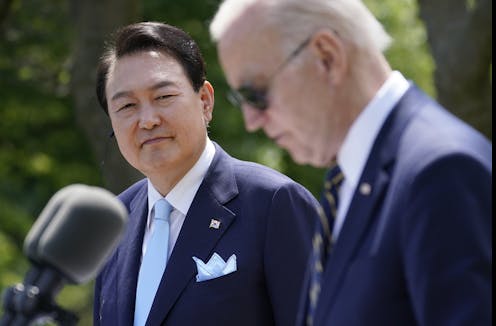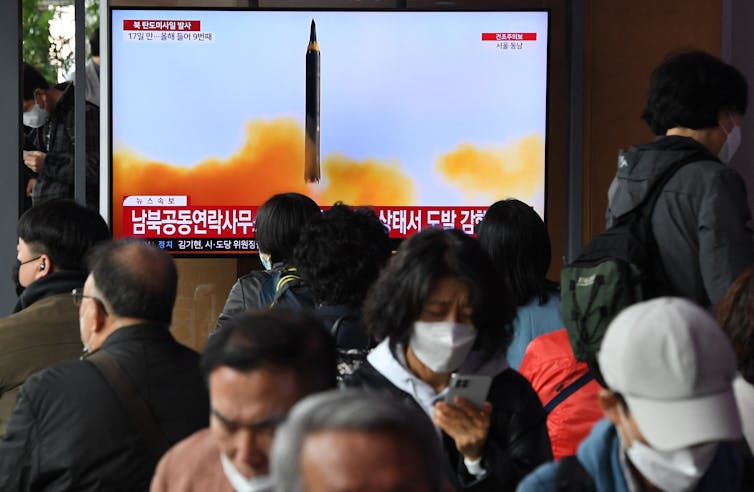US-South Korea nuclear weapons deal – what you need to know
The ‘Washington Declaration’ unveiled during the state visit by South Korean President Yoon Suk Yeol gives Seoul a greater role in coordinating a nuclear response strategy.

The United States and South Korea have unveiled an agreement under which leaders in Seoul will be handed an enhanced role in planning any nuclear response to a strike in the region by North Korea.
Announced at a state visit to Washington by South Korean President Yoon Suk Yeol on April 26, 2023, the so-called “Washington Declaration” will see U.S. deployments of “strategic assets” around the Korean Peninsula, including an upcoming visit by a nuclear submarine. The last time the U.S. had nuclear weapons in South Korea was 1991
The Conversation asked Sung-Yoon Lee, an expert on U.S.-Korean relations at Tufts University, to explain what the decision to revamp nuclear relations means and why it has come now.
What is in the ‘Washington Declaration’?
Well, there’s strong language. Whereas the U.S. has repeatedly “reaffirmed” its commitment in the past to the defense of South Korea, the wording in the Washington Declaration is more robust. It builds on the language contained in the joint statement released during Biden’s visit to Seoul soon after Yoon assumed office in May 2022. On that occasion, the U.S. pledged its “extended deterrence commitment to the (Republic of Korea) using the full range of U.S. defense capabilities, including nuclear, conventional and missile defense capabilities.”
This time, lest there be doubt, that affirmation is made “in the strongest words possible.”
But what does that mean in real terms? First, the U.S. “commits to make every effort to consult with the (Republic of Korea) on any possible nuclear weapons employment on the Korean Peninsula.”
More substantively, the two sides commit “to engage in deeper, cooperative decision-making on nuclear deterrence,” including through “enhanced dialogue and information sharing regarding growing nuclear threats” to South Korea.
It will come as a welcome development to decision-makers in South Korea, although it raises questions about just how much intel on North Korea’s threat and capabilities the U.S. – and Japan, with its advanced signal intelligence systems – did not share with previous administrations in Seoul.
Second, the two allies will establish a new nuclear consultative group to “strengthen extended deterrence, discuss nuclear and strategic planning and manage” the growing threat posed by Pyongyang. This means Seoul now will have a seat at the table when it comes to planning any nuclear response strategy and in readying its “conventional support to U.S. nuclear operations in a contingency.”
In sum, Seoul will now have a much greater say in intel-sharing and planning for a joint long-term nuclear strategy, with a focus on its own role in any future flare-up in the Korean Peninsula.
It is a big step forward.
Why are the US and South Korea announcing this now?
The international security environment has drastically changed over the past year, necessitating credible countermeasures from the two allies, in cooperation with Japan. North Korea has fired well over 100 missiles since January 2022. Meanwhile, Russia’s invasion of Ukraine and its many alleged war crimes have only pulled China and North Korea closer into its sphere. And China has gone beyond its usual “wolf-warrior diplomacy” rhetoric by conducting threatening military drills around Taiwan last August and, again, this April.
The Washington Declaration comes on the 70th anniversary of the alliance between Washington and Seoul. The timing serves as an opportunity to reflect on and reassess the relationship. But, no doubt, the main drivers in this strongly worded reaffirmation of the alliance are the recent actions taken by the governments in Pyongyang, Moscow and Beijing.
How has South Korea’s position on nuclear options evolved?
The Korean Peninsula has been through two periods of actual “denuclearization” since the 1953 armistice that ended combat during the Korean War.
The first was in the 1970s when the U.S., catching wind of South Korea’s secret nuclear weapons program, threatened to withdraw all U.S. troops from the South unless Seoul completely dismantled the program. And, so, the government abandoned its nuclear ambitions.
The second came in 1991 when the U.S. and South Korea – perhaps anticipating the coming collapse of the Soviet empire and a severely debilitated North Korea – agreed to withdraw all U.S. tactical nuclear weapons from the South, even as the North was working on its own nuclear program while vigorously talking “denuclearization.”
But in recent years, public opinion in South Korea has strongly shifted toward self-nuclearization rather than rely on the U.S. stockpile off South Korea’s shores. North Korea’s relentless pursuit of more powerful nuclear and missile capabilities, starting with the resumption of ballistic missiles tests in May 2019 after an 18-month lull, has stiffened views in the South.
President Yoon himself floated the idea of self-nuclearization earlier this year. But the Washington Declaration appears to have tempered down such sentiment. In it, Yoon “reaffirmed the (Republic of Korea’s) longstanding commitment” to the Nuclear Nonproliferation Treaty, which would prevent the country from building up its own nuclear weapons stockpile.
How will the declaration affect regional tensions?
A staple of North Korean propaganda is that its arms program is a response to U.S. “hostile policy” – which Pyongyang defines as anything from Washington raising concerns about its egregious human rights record to the stationing of U.S. troops in South Korea and joint U.S.-South Korea military drills.

As such, it is reasonable to assume that Pyongyang will respond with a threatening act or two in the coming days. Using the Washington Declaration as cover, expect North Korea to embark on another brazen act of defiance. Last December, Kim Yo Jong, the North Korean leader’s sister and deputy, threatened an intercontinental ballistic missile test on a normal trajectory, rather than the steep angle launches that avoid threatening nearby countries. And in 2017, North Korea’s former foreign minister Ri Yong Ho suggested that Kim Jong Un was considering testing a hydrogen bomb test over the Pacific. Either would represent a ratcheting up of North Korea’s provocations.
China, meanwhile, is likely to fall back on its decades-old mantra that issues on the Korean Peninsula need to be resolved “through dialogue” – a position that not only fails to penalize Pyongyang but indirectly empowers the isolationist state.
Sung-Yoon Lee does not work for, consult, own shares in or receive funding from any company or organization that would benefit from this article, and has disclosed no relevant affiliations beyond their academic appointment.
Read These Next
From truce in the trenches to cocktails at the consulate: How Christmas diplomacy seeks to exploit s
World leaders like to talk up peace at Christmastime. But alongside the tales of seasonal breaks in…
People are getting their news from AI – and it’s altering their views
Even when information is factually accurate, how it’s presented can introduce subtle biases. As large…
Autocracies in transition: In 2025, Cameroon and Tanzania rulers clung to power — but look more vuln
The countries, whose respective leaders recently won widely disputed elections, offer contrasting examples…






